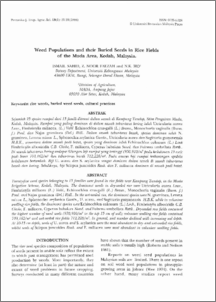Citation
Sahid, Ismail and Z., Nor Faezah and Ho, N. K.
(1995)
Weed Populations and their buried seeds in rice fields
of the Muda Area, Kedah, Malaysia.
Pertanika Journal of Tropical Agricultural Science, 18 (1).
pp. 21-28.
ISSN 0126-6128
Abstract
Twenty weed species belonging to 15 families were found in rice fields near Kampung Tandop, in the Muda
Irrigation Scheme, Kedah, Malaysia. The dominant weeds in dry-seeded rice were Utriculatia aurea Lour.,
Fimbristylis miliacea (L.) Vahl., Echinochloa cruss-galli (L.) Beauv., Monochoria vaginalis (Burm. f)
Presl and Najas graminea (Del.) Ridl.. In the wet-seedled rice, the dominant species were N. graminea, Lemna
minor L, Sphenoclea zeylanica Gaertn., U. aurea, and Sagiuaria guayanensis H.B.K. while in volunteer
seedling rice fields, the dominant species were Echinochloa colollllm (L.) Link., Fimbristylis alboviridis C.B.
Clarke, F. miliacca, Cyperus babakan Steud. and Fuirena umbellata Rottb.. Dry-seeded rice fields contained
the highest number of weed seeds (930,910/m2. in the top 15 inch of soil); volunteer seedling rice fields contained 793, 162/m2 and wet-seeded rice fields 712,228/m2. In general, seed number declined with increasing soil depth.
At 10-15 cm depth, seed of U. aurea and S. zeylanica were tile most abundant in dry- and wet-seeded rice fields,
whilst seeds of Scirpus juncoides Roxb. and F. miliacea were most abundant in volunteer seedling fields.
Download File
![[img]](http://psasir.upm.edu.my/style/images/fileicons/application_pdf.png)  Preview |
|
PDF
Weed_Populations_and_their_Buried_Seeds_in_Rice_Fields.pdf
Download (2MB)
|
|
Additional Metadata
Actions (login required)
 |
View Item |

